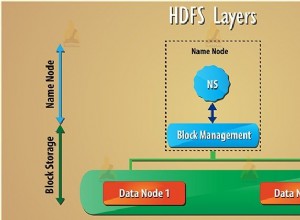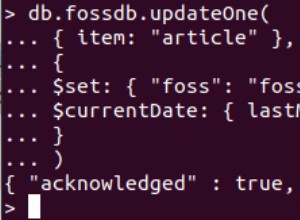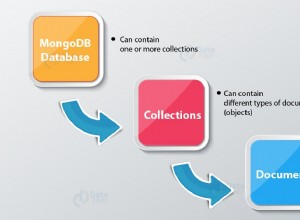MongoDB 4.0 e versioni successive
Usa $toDate
db.session_log.aggregate([
{ "$group": {
"_id": {
"$dateToString": {
"format": "%Y-%m-%d",
"date": {
"$toDate": {
"$multiply": [1000, "$LASTLOGIN"]
}
}
}
},
"count": { "$sum": 1 }
} }
])
o $convert
db.session_log.aggregate([
{ "$group": {
"_id": {
"$dateToString": {
"format": "%Y-%m-%d",
"date": {
"$convert": {
"input": {
"$multiply": [1000, "$LASTLOGIN"]
},
"to": "date"
}
}
}
},
"count": { "$sum": 1 }
} }
])
MongoDB>=3.0 e <4.0:
db.session_log.aggregate([
{ "$group": {
"_id": {
"$dateToString": {
"format": "%Y-%m-%d",
"date": {
"$add": [
new Date(0),
{ "$multiply": [1000, "$LASTLOGIN"] }
]
}
}
},
"count": { "$sum": 1 }
} }
])
Dovresti convertire il LASTLOGIN campo in un timestamp di millisecondi moltiplicando il valore per 1000
{ "$multiply": [1000, "$LASTLOGIN"] }
, quindi converti in una data
"$add": [
new Date(0),
{ "$multiply": [1000, "$LASTLOGIN"] }
]
e questo può essere fatto nel $project
pipeline aggiungendo i tuoi millisecondi a un Date(0) di zero millisecondi oggetto, quindi estrarre $year
, $month
, $dayOfMonth
parti dalla data di conversione che puoi quindi utilizzare nel tuo $group
pipeline per raggruppare i documenti per giorno.
Dovresti quindi modificare la tua pipeline di aggregazione in questo:
var project = {
"$project":{
"_id": 0,
"y": {
"$year": {
"$add": [
new Date(0),
{ "$multiply": [1000, "$LASTLOGIN"] }
]
}
},
"m": {
"$month": {
"$add": [
new Date(0),
{ "$multiply": [1000, "$LASTLOGIN"] }
]
}
},
"d": {
"$dayOfMonth": {
"$add": [
new Date(0),
{ "$multiply": [1000, "$LASTLOGIN"] }
]
}
}
}
},
group = {
"$group": {
"_id": {
"year": "$y",
"month": "$m",
"day": "$d"
},
"count" : { "$sum" : 1 }
}
};
Esecuzione della pipeline di aggregazione:
db.session_log.aggregate([ project, group ])
darebbe i seguenti risultati (basati sul documento di esempio):
{ "_id" : { "year" : 2014, "month" : 1, "day" : 3 }, "count" : 1 }
Un miglioramento sarebbe eseguire quanto sopra in un'unica pipeline come
var group = {
"$group": {
"_id": {
"year": {
"$year": {
"$add": [
new Date(0),
{ "$multiply": [1000, "$LASTLOGIN"] }
]
}
},
"mmonth": {
"$month": {
"$add": [
new Date(0),
{ "$multiply": [1000, "$LASTLOGIN"] }
]
}
},
"day": {
"$dayOfMonth": {
"$add": [
new Date(0),
{ "$multiply": [1000, "$LASTLOGIN"] }
]
}
}
},
"count" : { "$sum" : 1 }
}
};
Esecuzione della pipeline di aggregazione:
db.session_log.aggregate([ group ])




